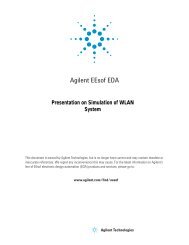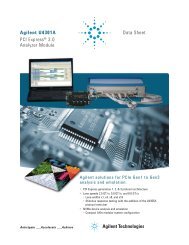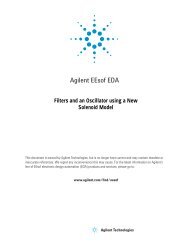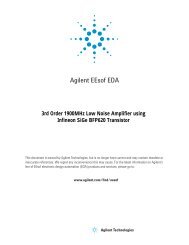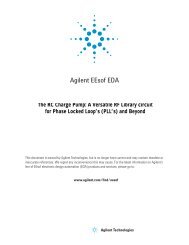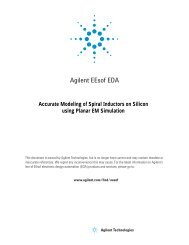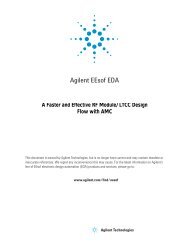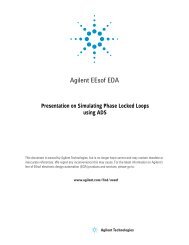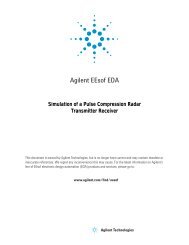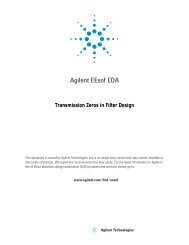Agilent 34980A Multifunction Switch/Measure Unit *34980-90005*
Agilent 34980A Multifunction Switch/Measure Unit *34980-90005*
Agilent 34980A Multifunction Switch/Measure Unit *34980-90005*
You also want an ePaper? Increase the reach of your titles
YUMPU automatically turns print PDFs into web optimized ePapers that Google loves.
1 Introduction to the <strong>34980A</strong><br />
Plug-In Modules<br />
System Cabling<br />
The <strong>34980A</strong> offers a complete selection of plug- in modules to give you<br />
high- quality measurement, switching, and control capabilities. The<br />
plug- in modules communicate with the main system processor via the<br />
internal digital bus. The multiplexer modules also connect to the internal<br />
DMM via the internal Analog Buses. Each module has its own<br />
microprocessor to offload the main system processor and minimize<br />
backplane communications for faster throughput. See Chapter 4,<br />
“Introduction to the Plug- In Modules for the <strong>34980A</strong>” for an overview of<br />
the available plug- in modules and their functions. Each module is<br />
shipped with its own User's Guide.<br />
Depending on your specific requirements, you can connect your device<br />
under test (DUT) to the <strong>34980A</strong> using several optional interconnection<br />
solutions (see “Interconnection Solutions Overview” on page 167).<br />
Detachable terminal blocks are available for low- frequency modules and<br />
offer an extremely flexible method for connecting external wiring. You<br />
can also connect to the plug- in modules directly using standard cabling<br />
with 50- pin D- Sub and 78- pin D- Sub connectors. Optional solder cup<br />
connector kits are also available if you choose to build your own custom<br />
cabling.<br />
The type of cabling that you use to connect your signals, transducers,<br />
and sensors to the module is critical to ensure measurement integrity.<br />
Some types of transducers, such as thermocouples, have very specific<br />
requirements for the type of cabling that should be used to make<br />
connections. Be sure to consider the usage environment when choosing<br />
wire gauge size and insulation qualities. Wire insulation typically consists<br />
of materials such as PVC or PTFE. The table below lists several common<br />
cable types and describes their typical uses.<br />
Cable Type Common Uses Comments<br />
Thermocouple<br />
Extension Wire<br />
Twisted Pair,<br />
Shielded Twisted<br />
Pair<br />
Shielded<br />
Coaxial,<br />
Double-Shielded<br />
Coaxial<br />
Flat Ribbon,<br />
Twisted Pair<br />
Ribbon<br />
Thermocouple<br />
measurements<br />
<strong>Measure</strong>ment inputs,<br />
voltage outputs,<br />
switching, counting<br />
Available in specific thermocouple types.<br />
Also available in a shielded cable for added<br />
noise immunity.<br />
Most common cable for low-frequency<br />
measurement inputs. Twisted pair reduces<br />
common mode noise. Shielded-twisted pair<br />
provides additional noise immunity.<br />
VHF Signal switching Most common cable for high-frequency<br />
signal routing. Available in specific<br />
impedance values (50 or 75). Provides<br />
excellent noise immunity. Double-shielded<br />
cable improves isolation between channels.<br />
Requires special connectors.<br />
Digital Input/Output Often used with mass termination<br />
connectors. These cables provide little<br />
noise immunity.<br />
6 <strong>Agilent</strong> <strong>34980A</strong> Mainframe User’s Guide





